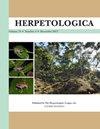平原猪鼻蛇日粮成分测定方法的比较
IF 1.1
3区 生物学
Q2 ZOOLOGY
引用次数: 1
摘要
摘要:野生动物日粮的量化具有一定的挑战性,各种量化方法各有优缺点。结合多种方法可以让生态学家评估他们对特定结果的信心水平,增加样本量,并在不同的时间尺度上调查饮食。传统的基于肠道内容物的方法的偏差大多是众所周知的。较新的方法可能有重要的偏差,这些偏差只能通过与现有方法的比较来解决。我们使用多种根本不同的方法收集了野生平原猪鼻蛇(Heterodon nasicus)的饮食数据,并使用贝叶斯框架对其进行分析,以描述个体发生的饮食变化。肠道内容物是最直接的,但产生的样本量很小,低于任何合理的阈值,无法进行概括。稳定同位素表明了明显的个体发生饮食变化,但这是劳动密集型的,结论受到多种方法警告的限制,包括猎物群体之间的相似性、母体的携带效应和营养富集因子的不确定性。粪便环境DNA (eDNA)在努力方面是中间的,产生的结果与其他两种方法一致,但如果我们没有同时使用这三种方法,其解释可能会因污染物而混淆。讨论了几个明显的伪影。这些方法之间有一些令人放心的相似之处。也有一些不同之处。最完整的图像使用所有方法综合的数据。未来的研究应该尝试更详细地比较这些方法和其他方法的偏差、费用和潜在缺点。本文章由计算机程序翻译,如有差异,请以英文原文为准。
Comparison of Three Methods for Measuring Dietary Composition of Plains Hog-nosed Snakes
Abstract: Wild animal diets are challenging to quantify, and the various methods for doing so have strengths and weaknesses. Combining multiple methods can allow ecologists to assess their level of confidence in particular results, increase sample size, and investigate diet over varying time scales. The biases of traditional gut content–based methods are mostly well understood. Newer methods may have important biases that can only be worked out through comparison to established ones. We collected data on the diet of wild Plains Hog-nosed Snakes (Heterodon nasicus) using multiple, fundamentally dissimilar methods, combined analytically using a Bayesian framework to describe an ontogenetic dietary shift. Gut contents were the most straightforward, but yielded a small sample size that fell below any reasonable threshold for making generalizations. Stable isotopes indicated an obvious ontogenetic dietary shift, but were labor-intensive, and conclusions are limited by multiple methodological caveats including similarity among prey groups, maternal carryover effects, and uncertainty in trophic enrichment factors. Fecal environmental DNA (eDNA) was intermediate in terms of effort, yielding results congruent with the other two methods, but the interpretation of which would likely have been confounded by contaminants had we not used all three methods in tandem. Several apparent artifacts are discussed. There are some reassuring similarities among methods. There are also several differences. The most complete picture uses data from all methods taken together. Future studies should attempt to compare the biases, expense, and potential drawbacks of these and other methods in greater detail.
求助全文
通过发布文献求助,成功后即可免费获取论文全文。
去求助
来源期刊

Herpetologica
生物-动物学
CiteScore
4.60
自引率
0.00%
发文量
27
审稿时长
>12 weeks
期刊介绍:
Established in 1936, Herpetologica is a quarterly peer-reviewed journal serving herpetologists, biologists, ecologists, conservationists, researchers and the scientific community. The journal contains original research papers and essays about the biology of reptiles and amphibians, and covers many relevant topics including: behavior, conservation, ecology, genetics, morphology, physiology and taxonomy.
 求助内容:
求助内容: 应助结果提醒方式:
应助结果提醒方式:


